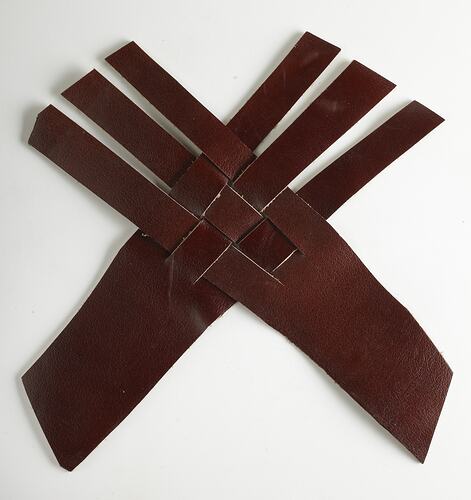Summary
This brown colored leather sample illustrates the weave found in Stanio Fancoff's 1950s basketweave shoes. Created from two leather pieces, each leather piece is sliced into three strands finishing at the midway point and interwoven. This sample was most likely a precursor to his shoeweave production and an integral part of his shoemaker's kit.
Stanio Ivanoff Fancoff was born in 1908 in Bojentsi, a small village in Bulgaria. At age 11, Stanio left home to learn the shoemaking trade. In 1929, he immigrated to Melbourne, settled in Fitzroy and began to work for the V.G. Zemancheff & Sons basket shoe factory in South Melbourne. In1936, he married Dorotea Georgi Touzou who had recently arrived in Australia. Around this time, Stanio set up his own shoemaking business from home, with Georgi, her cousin and sister weaving the shoes which he then assembled. Select shoe samples were then taken to Sydney and Tasmania for sale. In 1942, Georgi and Stanio moved to Broken Hill for Georgi's health; there daughter Nancy was born and Stanio set up a shoe shop/factory. In 1945, Georgi died and by 1950 Stanio and Nancy had moved to Adelaide where he again opened a shoemaking business and shop. He passed away in 1978, having been in the shoemaking business for 59 years. This collection documents his migration and working life experiences.
Physical Description
Two rectangular-shaped brown leather pieces, in which both pieces have two parallel slices to create three equal strands that end at approximately the midway point. These six strands are interwoven within an under/over fashion to create a criss-cross or checkered weave format. The straight edge form suggests this piece was sliced with a knife and ruler. While the front side appears smooth with a slight sheen, the reverse side exhibits the skin's natural fibres.
Significance
This collection is significant in documenting a small migrant business as well as the fashion of a particular period. It is well provenanced and charts the application of trade skills in a new country. It also illustrates the stages of hand shoe manufacture from the 1930s, demonstrating the enduring nature of the tools and patterns that were used.
More Information
-
Collecting Areas
-
Acquisition Information
Donation from Nancy Vasileff, 21 Mar 2007
-
Maker
-
Classification
-
Category
-
Discipline
-
Type of item
-
Overall Dimensions
225 mm (Length), 220 mm (Width)
-
References
R.A. Salaman, 'Dictionary of Leather-working Tools c.1700-1950 and Tools of Allied Trades,' London: George Allen and Unwin (Publishers) Ltd, 1986 [Section 2: Boot and Shoe Maker pp18-185]. John Peacock. 'Shoes, The Complete Sourcebook,' London:Thames & Hudson Ltd, 2005. NAA holds file (online) on Vasil George Zemancheff, Fancoff's employer
-
Keywords
Boot & Shoemaking, Bulgarian Communities, Bulgarian Immigration, Immigration, Small Businesses, Tools

